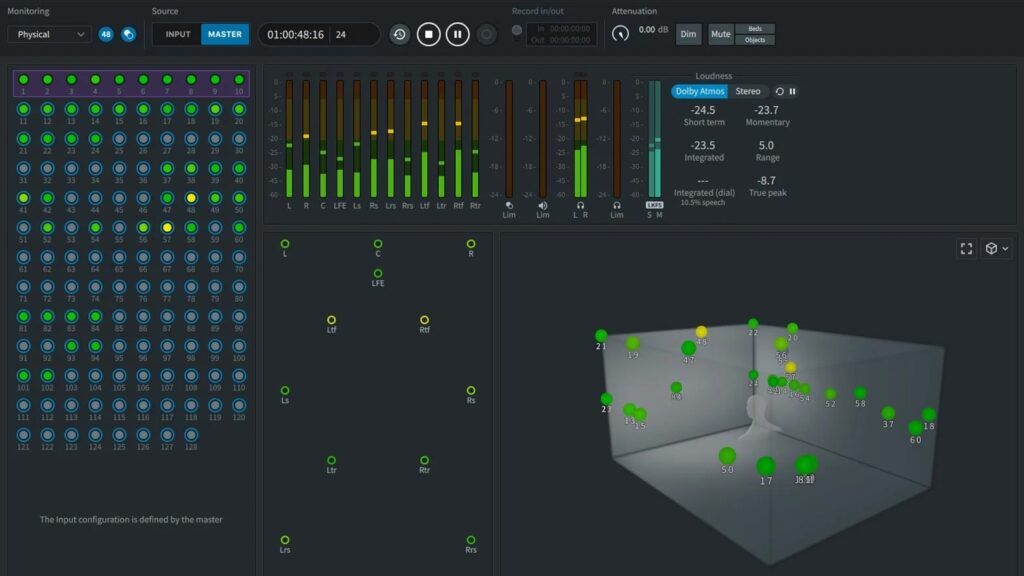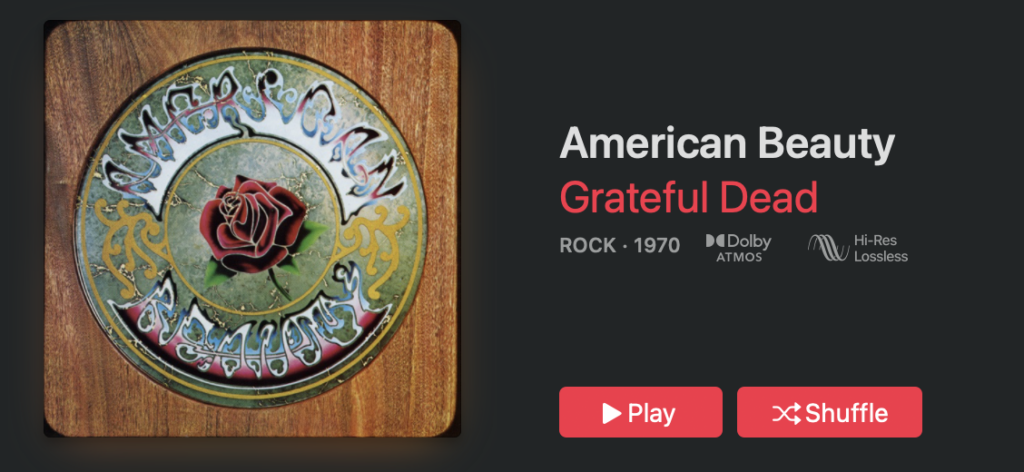Dolby Atmos object-based immersive audio is a paradigm-shifting technology for a variety of reasons, perhaps most notably due to its ability to automatically expand-and-contract based on the number of speakers available in one’s listening setup. As such, the same mix can be enjoyed on anything from earbuds or a soundbar to a 5.1 or 7.1.4 home theater setup.
If the early-2000s push for 5.1 surround sound music failed because said recordings could only be enjoyed on a six-channel speaker system, then Dolby Atmos certainly stands a better chance of catching on beyond the audiophile market. On paper, it’s never been a more exciting time to be a fan of immersive music.
Whereas 5.1 surround sound maintained a niche following throughout the 2010s - mostly due to the laudable efforts of independent labels like KScope/Snapper and musicians/engineers such as Steven Wilson or Bruce Soord - releases were infrequent and the choice of new titles was relatively slim, mostly centered around the progressive rock genre (Jethro Tull, King Crimson, Yes, etc).
Today, if you’re subscribed to a streaming service like Apple Music or Tidal, new Dolby Atmos mixes of both modern and vintage music in nearly every genre appear by the dozen on a weekly basis. Notable acts both old and new have embraced the format, from Taylor Swift and The 1975 to Joni Mitchell and The Grateful Dead.
So why are so many longtime surround music fans and audiophiles dissatisfied with the new status quo? We believe it comes to two key issues: ownership and sonic quality.

The Sonic Drawbacks Of Immersive Streaming
While streaming services offer convenience and access to a vast library of music, they also severely compress the audio to save bandwidth. This results in a notable loss of sonic quality and detail in comparison to the original ADM BWF Dolby Atmos master files.
"You’re essentially looking at a 2 GB Atmos file reduced to about 50 MB. I’m hoping they’ll be able to increase the file size over time, as home internet speeds improve."
Steven Wilson, award-winning musician/producer/engineer (link)
The ADM (Audio Definition Model) master format is essentially a massive WAV file with all the bed and object channels contained as separate tracks, so a single song can take up several gigabytes depending on how many unique objects the mixer has utilized. These files are obviously far too large to distribute directly to consumers, and the speaker mapping metadata contained within can only be interpreted by the Dolby Atmos Renderer application.
When an ADM master is submitted to the streaming services via AvidPlay or Distrokid, it’s converted to the Dolby Digital+/Joint Object Coded (E-AC3) format. This is a lossy conversion, much like WAV to MP3, that reduces the file size roughly 20 times. In order to keep the file size that low, the perceptual coding algorithm throws out so much data that it’s easy to detect MP3-like ‘metallic’ or ‘watery’ artifacts in the rear surround and height speakers.

Dolby Atmos releases on Blu-Ray disc instead use the lossless Dolby TrueHD format, which reduces the file size 10 times from the source master. The MLP (Meridian Lossless Packing) compression algorithm keeps the file size at a much more manageable 200-300 MB per track while also maintaining a sonic quality indistinguishable to the source ADM.
Below, for comparison purposes, we’ve provided a short sample of the same section - height channels only - from A Bad Think’s song “Hungry Eyes” in ADM, TrueHD, and DD+/JOC formats.
Dolby TrueHD (Blu-Ray/Digital Download)
The lack of detail and ‘underwater’ quality to the drum ambience in the Dolby Digital+ sample is strikingly apparent in isolation, but perhaps less so in the context of the full 12-channel mix. This isn't all to say streaming doesn’t have its place - for instance, it’s great being able to preview an Atmos mix without spending $100+ on a box set - and with no lossless version to compare with, many streaming-exclusive releases sound excellent.
However, given that music streaming is essentially a rental service at heart, users run the risk of having favorite albums or songs being removed or replaced without notice. The Dolby Atmos versions of a number of albums, such as Lord Huron’s Long Lost (2021) and Linkin Park's Hybrid Theory (2000), have been unceremoniously deleted from both Apple Music and Tidal with no explanation.

The Issue Of Ownership
Before 2020, immersive music was released only via physical media. Some may recall the 5.1 DVD-Audio and Super Audio CD formats of the early-2000s, but from 2010 on, most 5.1 releases have come via standard DVD-V (with a DTS or Dolby AC-3 soundtrack) or Blu-Ray disc (with a DTS-HD or DolbyTrueHD soundtrack). Dolby Atmos, contained within a Dolby TrueHD 7.1 container, could only be delivered via Blu-Ray.
Much has been said about the ongoing decline of physical media - despite the unexpected resurgence of vinyl - and from a financial standpoint, it’s understandable why record companies are reluctant to invest in authoring and manufacturing audio-only Blu-Ray discs. As such, these discs tend to be included as a selling point within larger deluxe sets containing additional CDs and even vinyl for a three-figure premium.
This tactic has worked well for labels in recent years, with immersive music fans investing upwards of $100 per album just to hear classics like The Beatles’ Abbey Road or Rush’s Moving Pictures in Dolby Atmos. It was certainly frustrating for many, but that costly one-time purchase at least guaranteed permanent ownership of the immersive mix.

While we don’t necessarily have statistics to prove it sold less than the prior reissues, the notable social media backlash towards The Beatles’ Revolver 50th anniversary box set - which did not include a Blu-Ray with Giles Martin’s Dolby Atmos mixes - does suggest that the inclusion (or lack thereof) of that disc may have been more of a make-or-break feature for fans than the label realized.
"That’s not my decision, even though I’ve been criticized for it, for some reason. [laughs] I mean, it’s great to have people be so passionate about it, because you never know. But there does seem to be a backlash about not having a Blu-ray for the Revolver box set, so we’ll probably have to address that at some point."
Giles Martin, award-winning producer/engineer (link)
How Does One Play These Files?
IAA offers hi-resolution digital downloads in the lossless Dolby TrueHD format. This codec is used to deliver immersive content on Blu-Ray disc, though it can also be embedded in an MKV video file for direct playback (via HDMI pass-through) on some Blu-Ray players - most notably the Oppo brand - as well as via free software media players like Kodi, VLC Media Player, or even Windows’ built-in “Movies & TV” video player. The net result is the full Blu-Ray experience (with the option to include video content too), but without the disc itself.
What Do Fans Really Think?
"..why is it such a tall order to get labels/artists/distributors (whoever handles these things) to offer Hi-Res Atmos downloads? Example - Van Morrison’s Moondance. There's an opportunity for them to make money with almost zero investment. They've already mixed the album, put it on Apple Music/Tidal etc. It's already been concluded that the effort to remix in Atmos was worth it. Personally, having a physical disc means nothing to me. I would gladly pay $30+ (or whatever the physical disc price is) for a high res Atmos download. I cannot be alone. Am I?"
Member, QuadraphonicQuad Surround Audio Forum (link)
"...if one can stream Atmos successfully, then one can also download uncompressed files. The expense to the publisher has to be much less than creating and shipping physical discs. Save the fake plastic trees!"
Member, QuadraphonicQuad Surround Audio Forum (link)
"[This] pretty much seems to be a universal problem with streaming [Dolby] Atmos. The dynamic range and depth just isn't there. I have Yello’s Point and Steven Wilson’s The Future Bites on Blu-Ray and they sound much better than streaming from Tidal. I'm sure it's because the bitrate just can't handle it."
Member, QuadraphonicQuad Surround Audio Forum (link)
"Turns out 768 Kbps is the max for DD+JOC which is what they're using for streaming at Apple [Music], but it can be lower. No wonder from a fidelity standpoint all the lossy Atmos mixes I've heard that are also available as TrueHD/Atmos on Blu-ray sound significantly poorer."
Member, Steve Hoffman Music Forum (link)
"Around 2005, I launched a start-up for downloadable 5.1 music not unlike what IAA is doing now. Until recently, it seemed like 5.1 surround music was over. That’s one reason I’m delighted to see IAA continuing and re-introducing the downloadable 5.1 music files concept."
John Kellogg, award-winning producer/engineer (link)
Conclusion
Overall, we strongly believe that releasing Dolby Atmos music in a Hi-Resolution digital file format (in addition to streaming) is a worthwhile and low-risk investment for record labels. Downloads are arguably the perfect "middle road" between streaming and Blu-Ray disc, where listeners get to keep a high-quality copy of the music without labels having to spend on authoring and disc replication.
All the major record labels continue to release stereo music as Hi-Resolution digital downloads via sites like HDTracks or Qobuz, so why not echo the same practice for immersive? Not only does it offer higher-quality audio for listeners - the sonic difference between lossy and lossless presentations of Dolby Atmos is far greater than that of stereo - but it also opens up exciting new opportunities for distribution and revenue, especially for independent acts that are unable to justify the expense of Blu-Ray.
